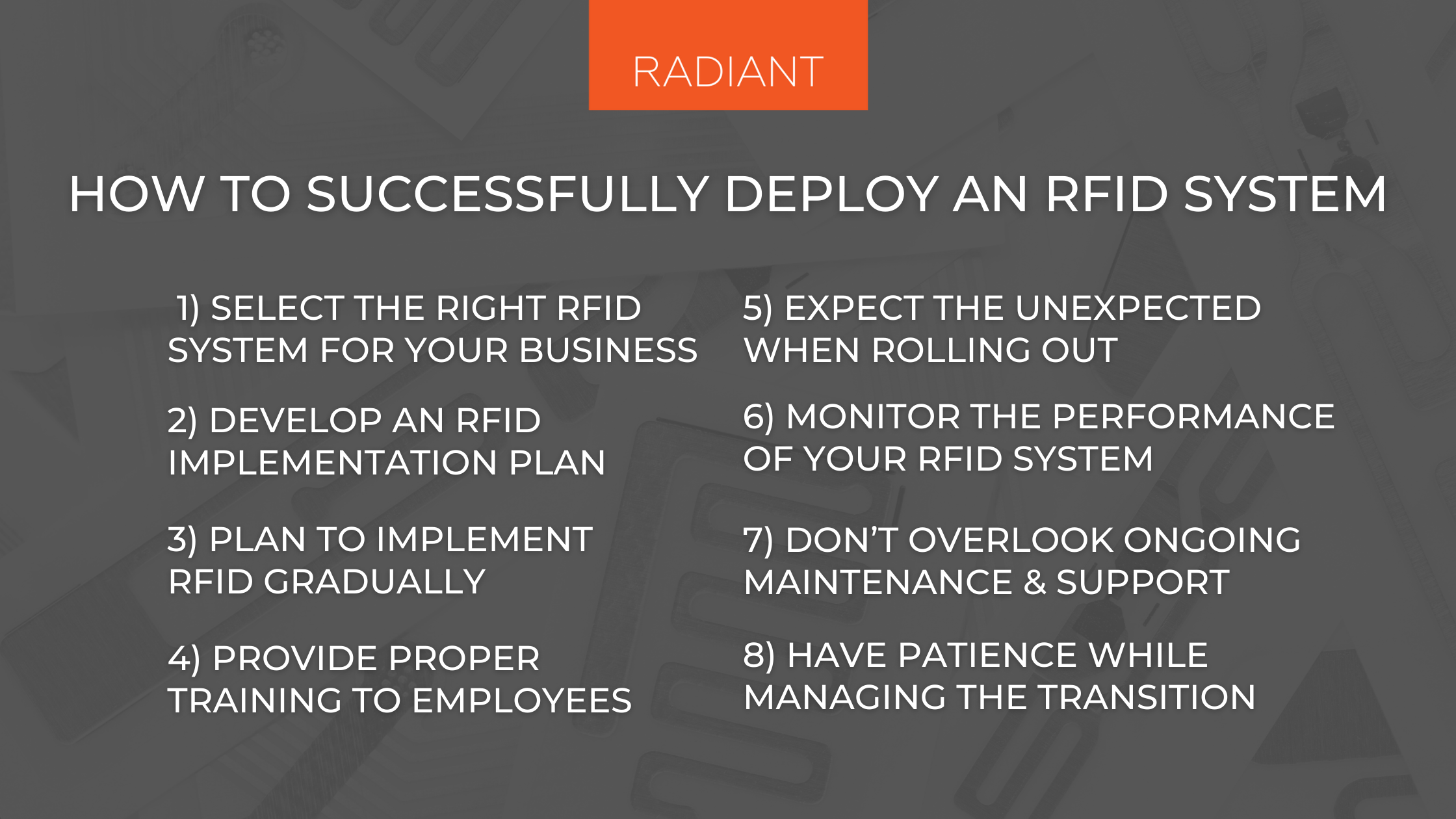When it comes to RFID implementation, there is no one-size-fits-all approach. Organizations must carefully evaluate their needs and select the right system and partners before embarking on an RFID system deployment.
By taking the time to plan your project, you can ensure a successful rollout, increase the return on your investment, and start realizing the benefits of RFID technology quickly. In this post, we’ll explore some key factors to consider when planning an RFID deployment. Keep reading to learn more.
What is an RFID System?
RFID stands for Radio Frequency Identification. RFID is a system that uses radio waves to identify and track objects through the use of asset tags, or small labels containing a chip and antenna. This Ultra High Frequency or UHF RFID tags can be read by an RFID reader from a distance of several feet away. Depending on the use case, RFID readers can either be handheld or fixed readers.
There are two main types of RFID tags used for uniquely identifying assets: active and passive.
- Active RFID tags have their own power source, which allows them to transmit their signal over long distances.
- Passive RFID tags do not have their own power source and instead rely on the radio waves emitted by an RFID reader to power passive tags.
As a result, passive RFID tags have a shorter read range than active RFID tags, but neither require a direct line of sight.
RFID solutions are used in many applications, including security, access control, inventory management, and asset tracking. RFID tags are often used in conjunction with barcodes, which provide a more detailed description of the item being tracked.
RFID applications are becoming increasingly popular as they offer a more efficient way to track and manage assets throughout the supply chain. However, implementing an RFID system can be complex, so the first step in ensuring a successful deployment is to select the right solution for your business.

1) Select the Right RFID System for your Business
Installing an RFID system is a big decision for any business. There are a lot of different vendors and solutions out there, and it can be tough to know which one is right for your company. Here are a few things to keep in mind when choosing an RFID system:
– What is the scope of your project? RFID systems can be used for simple tasks like inventory management, or for more complex applications like tracking people or assets. Be clear about the goals of your project, and select a system that is well suited to your needs.
– What is your budget? RFID systems can vary widely in price, depending on features and functionality. Work with your team to determine how much you are willing to spend on an RFID system, and look for vendors that offer solutions within your budget.
– What do you need to track? RFID tags can be used to track just about anything – people, assets, inventory, etc. Decide what you need to track before you start looking at RFID systems, as this will help narrow down your hardware and software options.
– Do you need real-time data? Some RFID systems offer real-time data tracking, while others only provide offline data. Think about whether you need real-time data tracking for your application, and select a system accordingly.
By taking the time to choose the right RFID system for your business, you can set yourself up for success. Work with your team to consider all of the factors above, and find a solution that meets your needs and budget.
With the right RFID system in place, you’ll be able to streamline your operations and take advantage of all that RFID technology has to offer.
2) Develop an RFID Implementation Project Plan
Once you have selected the right RFID system, you need to develop a clear understanding of how you plan to use it.
This will involve working with your RFID provider, conducting a site survey, mapping out your business processes, and determining where the RFID system can be used to improve efficiency or accuracy.
Once you have developed a clear plan, you need to commit the necessary resources to make sure the implementation is successful. This includes ensuring that you have the right staff in place to manage the project, as well as adequate funding to cover the costs of the RFID system and its deployment.
By taking the time to carefully plan for your RFID implementation, you can improve your chances of achieving a successful outcome.
3) Consider Implementing Your RFID System Gradually
Any business looking to deploy an RFID system needs to take care to do so gradually.
A hasty or haphazard deployment is likely to lead to technical difficulties and user resistance, both of which can hamper the success of the system. Instead, businesses should take a phased approach, starting with a pilot project in order to work out any kinks before expanding the system.
This will give employees time to get used to the new technology and help ensure that the RFID system is deployed smoothly and successfully.
4) Provide Proper Training on your RFID System to Employees
When it comes to RFID system implementation, one of the most important factors for success is employee training.
A poorly trained workforce can quickly lead to an RFID system that is not being used to its full potential, or even worse, not used at all.
Your RFID system champion and the project manager must work together to ensure that employees are properly trained on how to use the system. This includes everything from understanding how the system works to be able to find and correct errors.
Without proper training, an RFID system will likely not be deployed successfully.
5) Expect the Unexpected when Rolling Out your RFID System
No matter how well you plan, there’s always a chance that something will go wrong when implementing an RFID system.
The RFID system is a complex piece of technology, and there are a number of potential issues that can occur during deployment. For example, RFID tags can become detached from objects, making them difficult to track. In addition, RFID readers can experience interference from metal objects or other electronic devices.
As a result, it is essential to have a plan in place for dealing with these and other issues that may arise. By being prepared for problems, businesses can help to minimize their impact and ensure their RFID deployment is successful.
6) Be Sure to Monitor the Performance of your RFID System
Another critical aspect of successfully deploying an RFID system is performance monitoring.
Performance monitoring involves tracking the RFID system’s effectiveness in meeting its intended goals. This data can then be used to make adjustments to the system, ensuring that it is operating at peak efficiency.
Without performance monitoring, it can be difficult to troubleshoot problems with an RFID system. In addition, performance data can be used to justify the cost of an RFID system to upper management.
As such, performance monitoring is essential for any business considering deploying an RFID system.
7) Don’t Overlook Ongoing Maintenance and Post-Implementation Support
Deploying an RFID system is a big investment and one that can pay off handsomely in terms of increased efficiency and accuracy. But as with any complex system, ongoing maintenance and support are essential for ensuring that the RFID system continues to operate at peak performance.
RFID systems are constantly evolving, and new software updates and firmware releases are released on a regular basis. In addition, RFID tags and readers are subject to wear and tear and may need to be replaced or repaired over time.
By investing in ongoing maintenance and support, businesses can ensure that their RFID system remains up-to-date and runs smoothly.
8) Have Patience While Managing the Transition to RFID
Any business considering RFID deployment must be patient in order to be successful. RFID is typically and most effectively rolled out in phases, with each phase building on the previous one.
To properly manage the transition to RFID, businesses must have a clear understanding of their goals and objectives, as well as a realistic timeline for implementation. They must also be prepared to invest in training and support for employees and to work closely with their RFID partner to ensure smooth deployment.
With careful planning and a commitment to patience, businesses can successfully deploy an RFID system and realize the many benefits it offers.
Find RFID Implementation Success with Radiant’s RFID System
RFID implementation can be a daunting task, but with careful planning and execution, it can be a great success.
Radiant has extensive experience in implementing RFID systems for businesses of all sizes and industries. Our team will work with you to develop a project plan tailored to your specific needs, and we’ll provide training and support throughout the entire process.
We understand that not everyone is familiar with RFID technology, so please don’t hesitate to reach out if you have any questions or concerns. We invite you to explore our RFID asset management solution and request your demo below.
Last Updated on September 22, 2022 by Radiant

